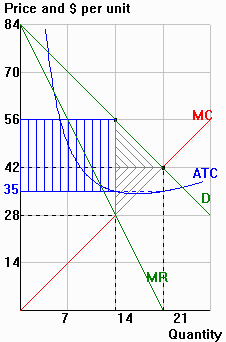| The Pimax Company is operated as a
profit-maximizing monopoly. Its total cost function is: TC = 294 + Q2 where TC = total cost in dollars, Q = output in units, and its (inverse) demand function is: P = 84 - 2.Q where P = price of output in dollars. |
|||
|
1. |
a. | (1) Profit-maximizing output:
14 (2) Price: 56 (3) Profits: 294 (4) MC: 28 (5) ATC: 35 Profit max => set MR = MC TR = PQ = (84-2Q)Q = 84Q-2Q2 => MR = 84 - 4Q TC = 294 + Q2 => MC = 2Q (1) MR=MC => 84-4Q = 2Q => Q = 14 (2) P = 84 - 2Q = 84 - 2(14) => P = 56 (3) Profits = TR - TC = 56.14 - (294 + 142) = 784 - 490 => Profits = 294 (4) MC = 2Q = 2(14) => MC = 28 (5) ATC = TC/Q = 490/14 => ATC=35 (ATC>MC=>ATC falling at Q=14) |
 |
| b. | Sketch Pimax's demand, marginal revenue, marginal cost and
average cost curves. Indicate in your diagram: (1) the efficient output level; (2) Pimax's
profit-maximizing output level and profits; and (3) the welfare loss at Pimax's output
level (1) Efficient Q=21; (2) Qm = 14; shaded box = profits; (3) shaded triangle = welfare loss Answer key checklist: (1) Did you make MC a straight line starting from the origin? (2) Did you make ATC rise when MC>ATC? (3) Did you use ATC at Qm for the bottom of your profits box? |
||